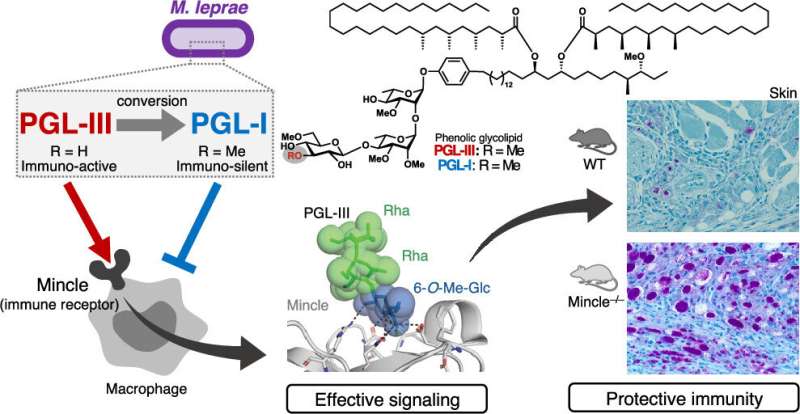This article has been reviewed according to Science X's editorial process and policies. Editors have highlighted the following attributes while ensuring the content's credibility:
fact-checked
peer-reviewed publication
trusted source
proofread
New research may lead to new types of treatments for leprosy

Leprosy has existed since at least Biblical times, yet scientists still don't know exactly how Mycobacterium leprae causes the disease's symptoms. Though antibiotics can treat the illness, researchers are concerned about the increase in drug-resistant strains.
Now, a team reporting in ACS Central Science has begun to understand the unique role certain immune receptors play in leprosy infections in mice, which could lead to new types of treatments for this disease and others in humans.
Thousands of people are currently affected by leprosy—also known as Hansen's disease—according to the World Health Organization. The disease can cause skin lesions, nerve damage and paralysis.
Once considered debilitating, antibiotics can now knock out an infection quickly and effectively. However, drug-resistant M. leprae strains have developed, prompting scientists to search for new treatment options.
As a first step, researchers have started to decipher the exact way the bacterium interacts with the immune system. The cell walls of mycobacteria like M. leprae have a thick lipid layer containing glycolipids—a combination of sugar and fat molecules—that the human immune system can recognize and act against. So, Jeroen D. C. Codée, Sho Yamasaki and colleagues wanted to better understand which glycolipids are responsible for leprosy's symptoms, and how they interact with the immune system.
The team extracted and synthesized the complex glycolipids from M. leprae, then exposed them to reporter cells expressing immune receptors. The component that activated the most cells was PGL-III, a precursor to the bacterium's most common glycolipid, PGL-I.
The team also discovered that this glycolipid used only its terminal sugar to bind an immune receptor called Mincle—a unique interaction not previously reported. Additionally, when mice without the Mincle receptor were exposed to M. leprae, they experienced worse infections than those with the receptor, suggesting that it plays an important role in the natural immune response against leprosy infection.
As a result, targeting this receptor or the PGL-III glycolipid could offer an alternative to the current, antibiotic-heavy treatment for leprosy. Even more, the researchers say that the special structure-activity relationship between Mincle and PGL-III could be replicated to create other immunostimulatory drugs in the future.
More information: Shigenari Ishizuka et al, PGL-III, a Rare Intermediate of Mycobacterium leprae Phenolic Glycolipid Biosynthesis, Is a Potent Mincle Ligand, ACS Central Science (2023). DOI: 10.1021/acscentsci.3c00040



















